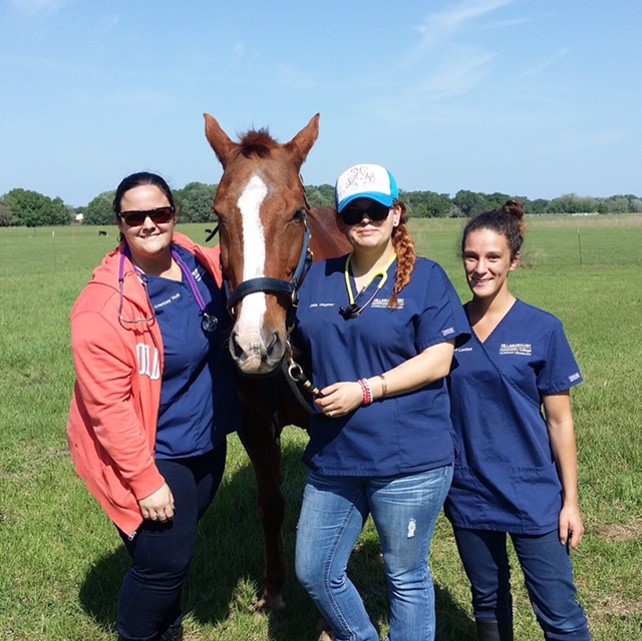Your furry, scaly and feathery friends need the best care possible. In order to make sure your pets stay healthy, veterinarians rely on the support of veterinary technologists and technicians. Vet techs perform many of the same duties for a vet that a nurse would for a physician. We recently caught up with Katie Van Lenten, a veterinary technologist/technician, to talk about how she’s excelled in the face of adversity along the unique path she took to this health care career.

ExploreHealthCareers.org (EHC): Thanks for your time, Katie! Let’s start with what inspired you to enter the healthcare field. How did you decide on this career path?
Katie Van Lenten (KVL): I have always liked science and helping people and animals in need. In high school, my favorite class was, believe it or not, Anatomy and Physiology. I also took a First Responder class and became a certified first responder. After graduating high school, I went to EMT school to become an EMT-B and during the program I got a part time job teaching preschool. For a while, teaching became my passion, but I always felt that I had a different purpose. Eight years into teaching, I decided to return to school to revisit my original calling — health care, of animals specifically — and I just graduated with an AS degree in Veterinary Technology.
EHC: Can you tell us about the award you received from your program
KVL: I was the 2016-2017 recipient of the Presidential Spotlight Award at my campus. This is an award given to students who excel in the face of adversity. At a young age, I contracted meningococcal meningitis and as a result, my right hand and left fingertips were amputated. Since this happened at such a young age, I have learned to cope and figure out unique ways to complete tasks that normally require two hands. In addition to rigorous course material, to become a credentialed vet tech there is a long list of psychomotor skills that you need to complete. This list includes things such as IV catheter placement, surgical assisting and endotracheal intubation of various species of animals. Completing these skills with any number of hands is a challenge! I just did what I have been doing since I was little: I saw a task in front of me and figured out how to complete it, safely and effectively.
EHC: Why vet tech specifically?
KVL: I adopted a dog when I moved to Florida and she very quickly became the center of my world. At one point, she got very sick and when I was at the emergency vet with her, I asked myself, “Why am I not doing this?” That’s when I began researching the requirements to become a vet tech.
Now, I am a CVT at an emergency clinic. I work as an overnight ER technician at the same hospital that saved my dog’s life three years ago. I rotate throughout different parts of the hospital doing things like triage, intensive care nursing and inpatient nursing, or I work “on the floor,” which means I am paired up with a doctor to work on their cases.
EHC: Please briefly describe how you got to this position.
 KVL: During school, I was required to do 240 hours of clinical training. 120+ of these hours I spent at my current hospital. When my rotations were over, I applied and thankfully, they decided to keep me (and start paying me, which is always nice!).
KVL: During school, I was required to do 240 hours of clinical training. 120+ of these hours I spent at my current hospital. When my rotations were over, I applied and thankfully, they decided to keep me (and start paying me, which is always nice!).
EHC: What advice do you have for students interested in going into your field?
KVL: Being a veterinary nurse is arguably the best job ever. If you have any doubts about it, see if you can volunteer at a local vet clinic and see what goes on there. In this field, you can’t be shy. You have to jump in and just try. No one is going to judge you if you fail at something. We were all new to this once. If you choose this field, you will be presented with unique situations every day and you will be a voice for the voiceless. That being said, vet nursing is also challenging, stressful and sometimes sad. The good outweighs the bad and the kisses you receive from a thankful patient will make your hard work worth it. Don’t give up.
Before I entered this field, I wish I knew how challenging school would be, but mostly, I just wish I had done it sooner. For some reason, I thought this career was not an option for me. People with disabilities should not rule out vet nursing, or any healthcare career. Life is too short to doubt yourself!
EHC: Finally, any tips for how those interested in this career field can say up to date on happenings in the healthcare field?
KVL: CVTs are required to have a certain amount of continuing education each year in order to keep current on the latest research and current events in the veterinary field. Conferences and small seminars are held throughout the country. Attending these is an awesome way to keep current and to network with other people in the field. There are also many awesome Facebook pages and blogs related to the veterinary field, one of my favorites is Vet Girl on the Run. I also subscribe to Today’s Veterinary Technician, the official monthly journal of The North American Veterinary Community.

Comment:
Hi my name is Madeline Byrne, from Pompton Plains, NO. I am the very proud aunt of Katie Van Lenten. She inspires me to achieve my goals in life.
Her motto “Never Give Up”. She is a remarkable woman.